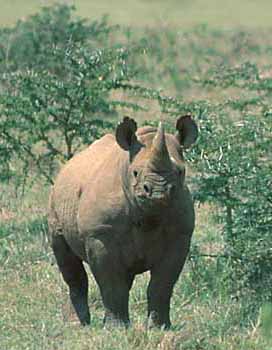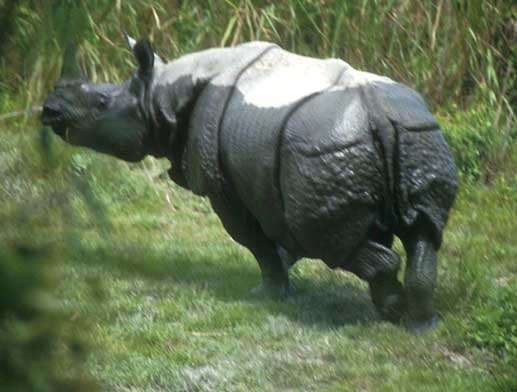

 There
are five species of Rhinoceroses (family Rhinocerotidae)
in the world, two in Africa and three in tropical Asia. All of them are
threatened or endangered. The "classic" rhino in the mind's eye is the
Black
Rhinoceros Diceros bicornis of Africa (right in a great
photo
by
W. Ed Harper). I have never seen one despite spending a month in Kenya
in 1981; quite to our surprise, they had become very rare by then. Poachers
decimated Black Rhino populations throughout Africa and today only isolated
fragments remain. Ed Harper's shot is from Ngorongoro Crater in northern
Tanzania, one of few places left on earth where one still has a reasonable
chance to see one (as hopefully I will some day soon).
There
are five species of Rhinoceroses (family Rhinocerotidae)
in the world, two in Africa and three in tropical Asia. All of them are
threatened or endangered. The "classic" rhino in the mind's eye is the
Black
Rhinoceros Diceros bicornis of Africa (right in a great
photo
by
W. Ed Harper). I have never seen one despite spending a month in Kenya
in 1981; quite to our surprise, they had become very rare by then. Poachers
decimated Black Rhino populations throughout Africa and today only isolated
fragments remain. Ed Harper's shot is from Ngorongoro Crater in northern
Tanzania, one of few places left on earth where one still has a reasonable
chance to see one (as hopefully I will some day soon).
The Black Rhino is a browser, often more nocturnal than diurnal. Until poachers nearly wiped it out (the horn is sold as dagger scabbards in the Middle East and rhino horn is sold as an aphrodisiac in southeast Asia), this was a very successful species. It once ranged from Somalia to South Africa and thrived in a wide variety of habitats, including montane forests in Kenya and the bleak Kalahari Desert of Namibia and Botswana. There is a fine book about recent research into the life history and survival of Black Rhinos in the Kalahari: Horn of Darkness: Rhinos on the Edge (1997) by Carol Cunningham & Joel Berger [Oxford Univ. Press, New York]. It tells the incredible story of finding and tracking rhinos in this bleak habitat. It also presents their politically incorrect finding that cutting off rhino horns in an attempt to save them was not a successful strategy anywhere that rhinos coexist with hyenas. Mother rhinos require their horns to protect the young from predators.
Black Rhinos are aggressive and unpredictable. Their charges can mangle vehicles. One must treat them with proper respect. In contrast, the White Rhinoceros Ceratotherium simum (below right) is rather placid. The two great shots below were taken by John Sullivan at Lake Nakuru in July 2000. Below on the left is the Black Rhino on alert; note the comparatively narrow muzzle and prehensile lips used for browsing in the thornscrub bushes. Below on the right is the White Rhino with its broad muzzle evolved from grazing. [White Rhinos are not "white;" the term is a mangling of the Afrikaner word for "wide" muzzle.They are the same gray color as Black Rhinos.]


Both species can have one or two horns. White Rhinos have a long head and lack the more "sway-back" appearance of Black Rhino; they also have less hairy ears. They are the second largest land animal in Africa, after African Elephant. The distribution of White Rhino was always patchy because they require extensive thick grasslands for grazing. They were almost wiped out by hunting a hundred years ago but "Operation Rhino" in the 1970s re-established populations across much of their former range, at least in southern Africa. The environmental project was so successful that the species was no longer consider "endangered." Now it is Black Rhinos that are on the edge of extinction.
Neither species was at Lake Nakuru when I was there in 1981; they have both since been re-introduced and are protected by guards. More photos and the whole story about these two (and two more Whites!) are on John Sullivan's website which I very much recommend. He writes that the two Cattle Egrets flanking the White Rhino were in attendance the entire time they spent with the huge beast.


As of this writing (Jan 2001), my only rhino of either species in Africa is this one White Rhino (above and right) in Kruger National Park, South Africa. We had been driving off the beaten path on a dirt side road when this rhino suddenly rambled down the road toward us as we were parked and looking at a small pond. By the time I could get my camera out it had turned and gone into the thickets, followed closely by a Yellow-billed Hornbill that was snatching up insects startled by the beast. You can sort-of see the horn and ears in the shots but the rhino never lifted its head from the dense grass.
There are three rare and endangered rhinos in tropical Asia. Both the
Javan Rhinoceros Rhinoceros sondaicus and the Sumatran Rhinoceros
Deicerorhinus
sumatrensis are almost extinct. The Javan Rhino, once ranging to India,
is now restricted to the lowlands on western Java where maybe only 50 remain.
The Sumatran Rhino is a mostly nocturnal rain forest animal from lowlands
into highlands in remote parts of Sumatra, Borneo, and southeast Asia;
a recent estimate is only 150 left. The best protected is the wonderfully
armored Indian Rhinoceros Rhinoceros unicornis (below).
Most of the 1500 or so left in the world are within Kaziranga National
Park in Assam, eastern India, where these shots were taken.


The Indian Rhino is very much a swampland species, evolved within the ecology of floodplain grasslands. It is mainly a grazer and can easily disappear into the tall grass. It is aggressive and dangerous and therefore one is restricted to staying within your vehicle in the national park. Our visit to Kaziranga was in the dry season and we did see a half-dozen or so rhinos on each morning or afternoon game drive. Like other rhinos, each male marks its territory with piles of dung, some of which are on the wide dirt roads through the reserve....
The taxonomy here follows Macdonald, D., ed. (1984) The Encyclopedia of Mammals, 1st ed. Facts on File Publ., New York. Other than personal experiences, the facts are mostly summarized from that text.
PHOTOS: All photos on this page are © 2001 Don Roberson except those that are © 2001 W. Ed Harper and © 2001 John Sullivan, and used with permission; all rights reserved. Ed Harper photographed the Black Rhinoceros at Ngorongoro Crater, Tanzania, in July 1999. The nice frontal shots of Black Rhino and White Rhino were taken in July 2000 at Lake Nakuru, Kenya, by John Sullivan. My White Rhinoceros was in Kruger National Park, South Africa, in July 1996. The Indian Rhinoceros was in Kaziranga National Park, Assam, India, in April 2001.